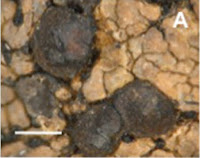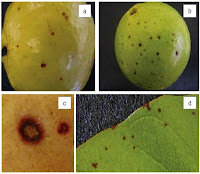Ascomycote Fungi of the order Jahnulales are aquatic wood decomposing Fungi found almost exclusively in freshwater environments (one species is known from Mangroves). Members of the genus Jahnula, from which the family gets its name, are primarily tropical in distribution, though some temperate species are known.
In a paper published in the journal MycoKeys on 9 March 2015, Jacques Fournier of Rimont in France, Huzefa Raja of the Department of Chemistry and Biochemistry at the University of North Carolina, and Carol Shearer of the Department of Plant Biology at the University of Illinois, Urbana, describe a new species of Jahnula from a river on Martinique Island in the Lesser Antilles.
The new species is named Jahnula purpurea, meaning 'purple', in reference to the colour which the Fungus stains the wood it lives on. This has never previously been seen in a member of the Jahnulales, and while other wood-decomposing Fungi are known to produce purple stains, these are not closely related to, and could not easily be confused with, the Jahnulales.
Jahnula purpurea, Ascomata on submerged wood. Note the purple stain. Scale bar is 500 μm. Fournier et al. (2015).
Jahnula purpurea has exceptionally small ascomata (fruiting bodies) for a member of the Jahnula. This has been seen only in one previous member of the genus, Jahnula marakotii, from peat swamps in Thailand, but this is quite dissimilar to Jahnula purpurea both in morphology and habitat.
Asci of Jahnula purpurea. Scale bars are 20 μm. Fournier et al. (2015).
See also...
 An unusual Pucciniomycote Fungus from Ecuador. Pucciniomycote Fungi (Rusts etc.) typically produce microscopic
fruiting bodies, though a few do produce larger sporocarps, typically with a
basal spore producing area, with spores being expelled through some sort of
structure above this. However the production of such bodies seems to be
scattered...
An unusual Pucciniomycote Fungus from Ecuador. Pucciniomycote Fungi (Rusts etc.) typically produce microscopic
fruiting bodies, though a few do produce larger sporocarps, typically with a
basal spore producing area, with spores being expelled through some sort of
structure above this. However the production of such bodies seems to be
scattered... A new species of Lichen-infecting parasitic Fungus from Scandinavia. Lichens are symbiotic organisms, each consisting of a Fungus and an
Alga, the Fungus obtaining nutrients from the substrate (surface upon which the
Lichen sits), while the Alga produces carbohydrates through photosynthesis.
They the Fungi and Algae involved..
A new species of Lichen-infecting parasitic Fungus from Scandinavia. Lichens are symbiotic organisms, each consisting of a Fungus and an
Alga, the Fungus obtaining nutrients from the substrate (surface upon which the
Lichen sits), while the Alga produces carbohydrates through photosynthesis.
They the Fungi and Algae involved.. The cause of Pink Spot Disease on Guavas in South Africa. Guavas, Psidium guajava,
are fruit bearing trees in the Myrtle Family, Myrtaceae, closely related to Eucalyptus. They are native to Mexico,
Central America and the Caribbean Islands, but have been introduced to many
countries as a commercial fruit crop, the largest producers being Mexico, India
and Brazil. Like most...
The cause of Pink Spot Disease on Guavas in South Africa. Guavas, Psidium guajava,
are fruit bearing trees in the Myrtle Family, Myrtaceae, closely related to Eucalyptus. They are native to Mexico,
Central America and the Caribbean Islands, but have been introduced to many
countries as a commercial fruit crop, the largest producers being Mexico, India
and Brazil. Like most...
Follow Sciency Thoughts on Facebook.


